Harbor Freight Tools 68827 Product manual
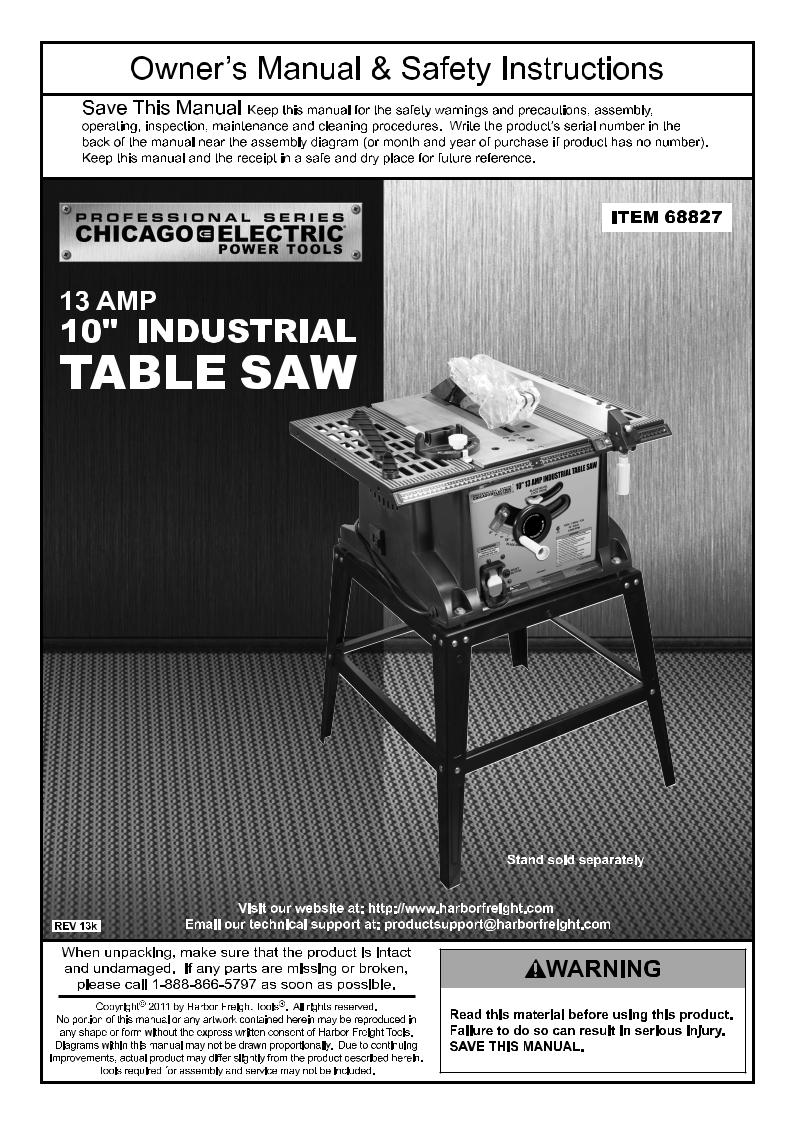
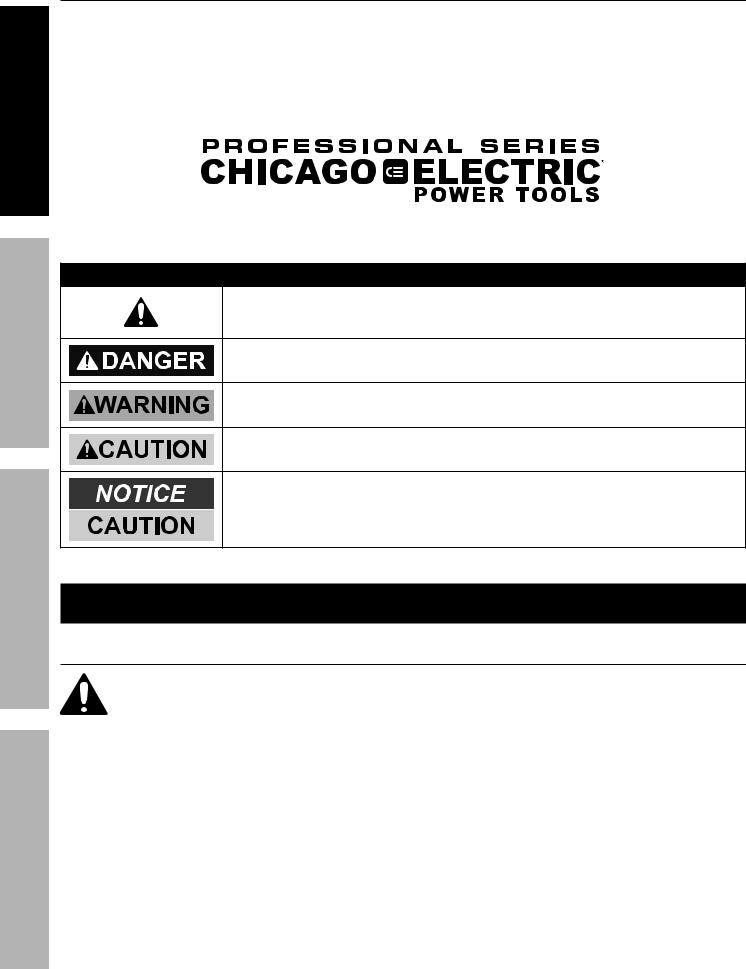
AFETS y
ETUPS
cE PERATION
AINTENANM
Table of contents
Safety ......................................................... |
2 |
Maintenance.............................................. |
15 |
Setup .......................................................... |
7 |
Parts List.................................................... |
18 |
Specifications ............................................. |
8 |
Assembly Diagram .................................... |
19 |
Operation................................................... |
12 |
Warranty .................................................... |
20 |
WARNING SyMBOLS AND DEFINITIONS
This is the safety alert symbol. It is used to alert you to potential personal injury hazards. Obey all safety messages that
follow this symbol to avoid possible injury or death.
Indicates a hazardous situation which, if not avoided, will result in death or serious injury.
Indicates a hazardous situation which, if not avoided, could result in death or serious injury.
Indicates a hazardous situation which, if not avoided, could result in minor or moderate injury.
Addresses practices not related to personal injury.
IMPORTANT SAFETy INFORMATION
General Tool Safety Warnings
WARNING Read all safety warnings and instructions.
Failure to follow the warnings and instructions may result in electric shock, fire and/or serious injury.
Save all warnings and instructions for future reference.
1.KEEP GUARDS IN PLACE and in working order.
2.REMOVE ADJUSTING KEYS AND WRENCHES. Form habit of checking to see that keys and adjusting wrenches are removed from tool before turning it on.
3.KEEP WORK AREA CLEAN. Cluttered areas and benches invite accidents.
4.DON’T USE IN DANGEROUS ENVIRONMENT. Don’t use power tools in damp or wet locations, or expose them to rain. Keep work area well lighted.
5.KEEP CHILDREN AWAY. All visitors should be kept safe distance from work area.
6.MAKE WORKSHOP KID PROOF with padlocks, master switches, or by removing starter keys.
7.DON’T FORCE TOOL. It will do the job better and safer at the rate for which it was designed.
8.USE RIGHT TOOL. Don’t force tool or attachment to do a job for which it was not designed.
Page 2 |
For technical questions, please call 1-888-866-5797. |
Item 68827 |
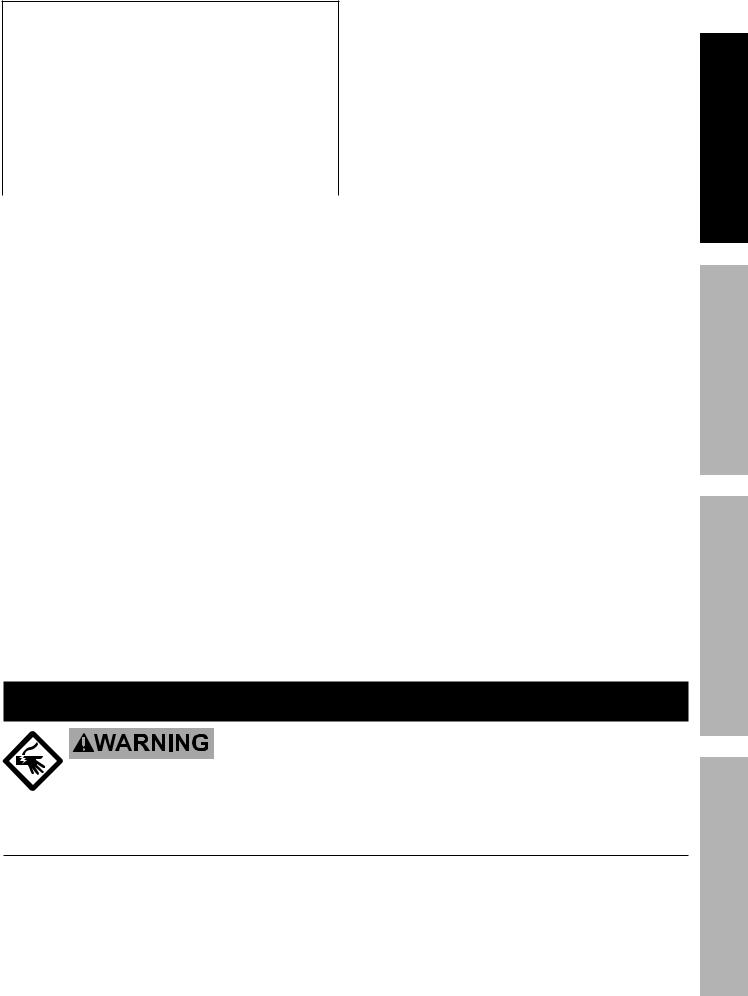
Table A: REcOMMENDED MINIMUM WIRE GAUGE FOR EXTENSION cORDS
(120 VOLT)
NAMEPLATE |
EXTENSION cORD LENGTH |
||||
AMPERES |
|
|
|
|
|
25 FT. |
50 FT. |
100 FT. |
150 FT. |
||
(at full load) |
|||||
0 – 6 |
18 |
16 |
16 |
14 |
|
6.1 – 10 |
18 |
16 |
14 |
12 |
|
10.1 – 12 |
16 |
16 |
14 |
12 |
|
12.1 – 16 |
14 |
12 |
Do not use. |
||
9.USE PROPER EXTENSION CORD. Make sure your extension cord is in good condition. When using
an extension cord, be sure to use one heavy enough to carry the current your product will draw. An undersized cord will cause a drop in line voltage resulting in loss of power and overheating. Table A shows the correct size to use depending on cord length and nameplate ampere rating.
If in doubt, use the next heavier gauge.
The smaller the gauge number, the heavier the cord.
10.WEAR PROPER APPAREL. Do not wear loose clothing, gloves, neckties, rings, bracelets, or other jewelry which may get caught in moving parts. Nonslip footwear is recommended. Wear protective hair covering to contain long hair.
11.ALWAYS USE SAFETY GLASSES. Also use face or dust mask if cutting operation is dusty. Everyday eyeglasses only have impact resistant lenses, they are NOT safety glasses.
12.SECURE WORK. Use clamps or a vise to hold work when practical. It’s safer than using your hand and it frees both hands to operate tool.
13.DON’T OVERREACH. Keep proper footing and balance at all times.
14.MAINTAIN TOOLS WITH CARE. Keep tools sharp and clean for best and safest performance. Follow instructions for lubricating and changing accessories.
15.DISCONNECT TOOLS before servicing; when changing accessories, such as blades, bits, cutters, and the like.
16.REDUCE THE RISK OF UNINTENTIONAL STARTING. Make sure switch is in
off position before plugging in.
17.USE RECOMMENDED ACCESSORIES. Consult the owner’s manual for recommended accessories. The use of improper accessories may cause risk of injury to persons.
18.NEVER STAND ON TOOL. Serious injury could occur if the tool is tipped or if the cutting tool is unintentionally contacted.
19.CHECK DAMAGED PARTS. Before further use of the tool, a guard or other part that is damaged should be carefully checked to determine that
it will operate properly and perform its intended function – check for alignment of moving parts, binding of moving parts, breakage of parts, mounting, and any other conditions that may affect its operation. A guard or other part that is damaged should be properly repaired or replaced.
20.DIRECTION OF FEED. Feed work into a blade or cutter against the direction of rotation of the blade or cutter only.
21.NEVER LEAVE TOOL RUNNING UNATTENDED. TURN POWER OFF. Don’t leave tool until it comes to a complete stop.
Grounding Instructions
SAFETy
SETUP
OPERATION
TO PREVENT ELEcTRIc SHOcK AND DEATH FROM INcORREcT GROUNDING WIRE cONNEcTION
READ AND FOLLOW THESE INSTRUcTIONS:
110-120 V~ Grounded Tools: Tools with Three Prong Plugs
1.In the event of a malfunction or breakdown, grounding provides a path of least resistance for electric current to reduce the risk of electric shock. This tool is equipped with an electric cord having an equipment-grounding conductor and a grounding plug. The plug must be plugged into a matching outlet that is properly installed and grounded in accordance with all local codes and ordinances.
2.Do not modify the plug provided – if it will not fit the outlet, have the proper outlet installed by a qualified electrician.
Item 68827 |
For technical questions, please call 1-888-866-5797. |
Page 3 |
MAINTENANcE
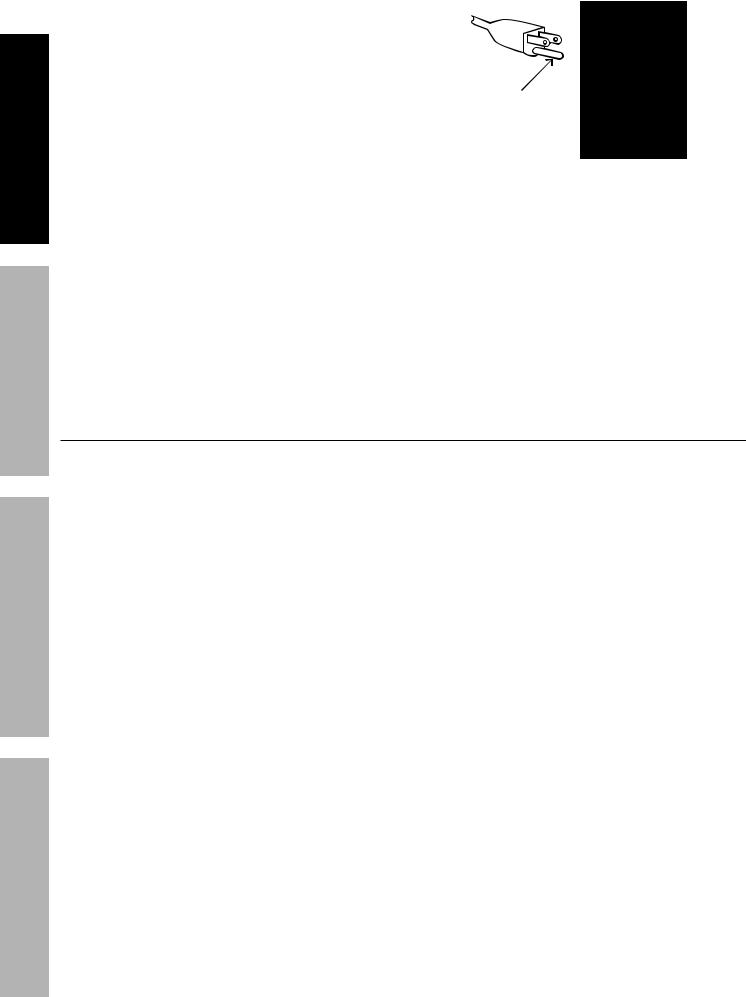
AFETS y
ETUPS
cE PERATION
AINTENANM
3.Improper connection of the equipment-grounding conductor can result in a risk of electric shock. The conductor with insulation having an outer surface that is green with or without yellow stripes is the equipment-grounding conductor.
If repair or replacement of the electric cord or plug is necessary, do not connect the equipmentgrounding conductor to a live terminal.
4.Check with a qualified electrician or service personnel if the grounding instructions are not completely understood, or if in doubt as to whether the tool is properly grounded.
5.Use only 3-wire extension cords that have 3-prong grounding plugs and 3-pole receptacles that accept the tool’s plug.
6.Repair or replace damaged or worn cord immediately.
Figure A: 125 V~ 3-Prong Plug and Outlet (for up to 125 V~ and up to 15 A)
7.This tool is intended for use on a circuit that has an outlet that looks like the one illustrated above in Figure A: 125 V~ 3-Prong Plug and Outlet. The tool has a grounding plug that
looks like the plug illustrated above in
Figure A: 125 V~ 3-Prong Plug and Outlet.
8.The outlet must be properly installed and grounded in accordance with all codes and ordinances.
9.Do not use an adapter to connect this tool to a different outlet.
Table Saw Safety Warnings
For your Own Safety Read Instruction Manual Before Operating Saw
1.Wear eye protection.
2.Use saw-blade guard and spreader for every operation for which it can be used, including all through sawing.
3.Keep hands out of the line of saw blade.
4.Use an appropriate push-stick when required.
5.Know how to reduce risk of kickback.
6.Do not perform any operation freehand.
7.Never reach around or over saw blade.
8.Make sure the workpiece is supported at all times while sawing. Use a roller stand (not provided) with larger workpieces if necessary.
9.To properly understand all safety warnings, be familiar with the following safety terms and equipment:
a.Featherboard – A block with “fingers″ that hold the workpiece against the fence while sawing.
b.Through-sawing – A cut made from one side of a board to the opposite side, without stopping.
c.Ripcut or Ripping - A cut made parallel to (along with) the grain of the wood.
d.Crosscut or Crosscutting - A cut made perpendicular (at a 90° angle) to the grain of the wood.
e.Push-stick – A narrow strip of wood or other soft material with a notch cut into one end and which is used to push short pieces
of material through saws. It provides a safe distance between the hands and the cutting tool. Must be narrower than the cut width to prevent contact with the blade.
f.Freehand – Feeding a workpiece through the saw without using a fence or guided support to guide it. NOT A SAFE METHOD.
g.Kerf – The gap made by the saw in the workpiece.
h.Kickback – A sudden reaction to a pinched, bound, or misaligned blade, causing
an uncontrolled workpiece to lift up and out of the saw toward the operator.
i.Spreader – A metal plate that follows the saw blade to keep the kerf (gap) from closing on the saw blade. Spreaders, except riving knives, must be aligned to the blade after blade adjustment to prevent binding.
j.Riving Knife – A spreader mounted on the same mechanism as the blade. Generally more effective than simple spreaders.
10.As noted previously, Kickback is a sudden reaction to a pinched, bound, or misaligned blade, causing an uncontrolled workpiece to lift up and out of the saw toward the operator.
Kickback is usually a result of tool misuse and can be limited or avoided by following the precautions below:
Page 4 |
For technical questions, please call 1-888-866-5797. |
Item 68827 |

•Fence must be completely parallel to the saw blade.
•Workpiece must be free from flaws
(such as loose knots) and from foreign objects (such as nails and screws).
•Support large workpieces along their entire length. Large workpieces tend to bend, grabbing the blade.
•Do not use a dull, damaged, or pitch-covered blade.
•Do not use fence as a guide when crosscutting.
•Do not ripcut a twisted or warped workpiece, or workpiece without straight
edge to guide along fence.
•Maintain control of the workpiece.
Do not allow the workpiece to rest against the moving blade without holding onto it.
•If the blade binds or a cut is interrupted,
turn off the power switch and hold the workpiece still until the blade stops. Correct the cause
of blade binding before proceeding.
•Before continuing an unfinished cut,
center the blade in the pre-cut kerf and check that the saw teeth are not engaged into the workpiece before turning on the saw.
•Push wood stock past the blade prior to release.
11.Check guards for proper operation with saw disconnected from power before each use. Do not disable any guard. Do not operate saw if any movable guard does not move freely and close instantly. Make sure any movable guard does not touch the blade in all angles, depths of cut, and positions.
12.Keep the guard in place while through-sawing. Verify that the spreader lines up with
the blade to prevent binding.
13.Construct an appropriate Push Stick out of wood according to the guidelines on the following page.
14.WARNING: Some dust created by power sanding, sawing, grinding, drilling, and other construction activities, contains chemicals known [to the State of California] to cause cancer, birth defects or other reproductive harm. Some examples of these chemicals are:
•Lead from lead-based paints
•Crystalline silica from bricks and cement
or other masonry products
• Arsenic and chromium from chemically treated lumber
Your risk from these exposures varies, depending on how often you do this type of work. To reduce
your exposure to these chemicals: work in a well ventilated area, and work with approved safety equipment, such as those dust masks that are specially designed to filter out microscopic particles.
(California Health & Safety Code § 25249.5, et seq.)
15.WARNING: Handling the cord on this product will expose you to lead, a chemical known to the State of California to cause cancer, and birth defects or other reproductive harm. Wash hands after handling. (California Health & Safety Code § 25249.5, et seq.)
16.The warnings, precautions, and instructions discussed in this instruction manual cannot cover all possible conditions and situations that may occur. It must be understood by the operator that common sense and caution are factors which cannot be built into this product, but must be supplied by the operator.
Vibration Safety
This tool vibrates during use. Repeated or long-term exposure to vibration may cause temporary or permanent physical injury, particularly to the hands, arms and shoulders. To reduce the risk of vibration-related injury:
1.Anyone using vibrating tools regularly or for an extended period should first be examined by a doctor and then have regular medical check-ups to ensure medical problems are not being caused or worsened from use. Pregnant women or people who have impaired blood circulation to the hand, past hand injuries, nervous system disorders, diabetes, or Raynaud’s Disease should not use this tool. If you feel any medical or physical symptoms related to vibration (such as tingling, numbness, and white or blue fingers), seek medical advice as soon as possible.
2.Do not smoke during use. Nicotine reduces the blood supply to the hands and fingers, increasing the risk of vibration-related injury.
3.Wear suitable gloves to reduce the vibration effects on the user.
4.Use tools with the lowest vibration when there is a choice between different processes.
5.Include vibration-free periods each day of work.
6.Grip tool as lightly as possible (while still keeping safe control of it). Let the tool do the work.
7.To reduce vibration, maintain the tool as explained in this manual. If any abnormal vibration occurs, stop use immediately.
 SAVE THESE INSTRUcTIONS.
SAVE THESE INSTRUcTIONS.
SAFETy
SETUP
OPERATION
MAINTENANcE
Item 68827 |
For technical questions, please call 1-888-866-5797. |
Page 5 |
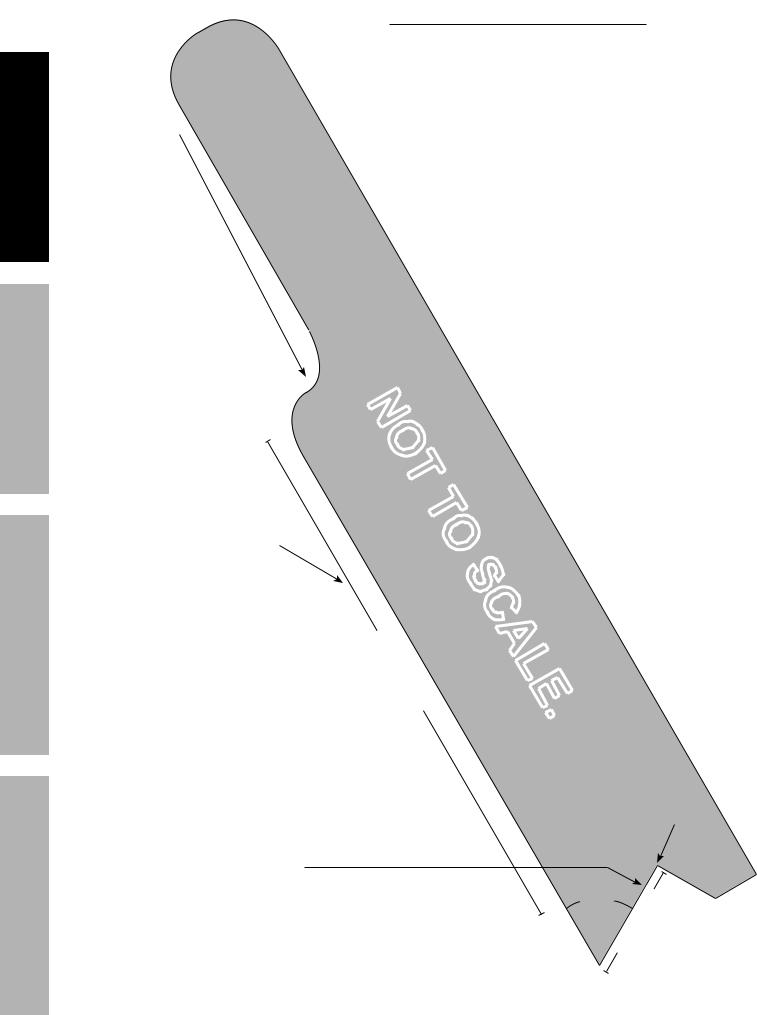
AFETS y
ETUPS
Handle Notch
•Must be far enough down the stick to allow a comfortable and firm grip.
•Must be deep enough to prevent hand from slipping down the stick.
•Do not cut more than halfway into the stick to prevent weakening.
•Corners may be rounded to increase comfort.
Essential Straight Push-stick
Features and Functions
Note: Straight style (traditional) stick shown. A different stick design may be used if it properly protects against all hazards.
Diagram not to scale.
•Push sticks must be made from sturdy, defect-free, plywood or normal wood to prevent unexpected breakage. Material must be at least 1/4" thick, but no thicker than the finished wood.
•Inspect push sti k before use and do not use a damagedALEcor deteriorated push stick.
• Push stick dimensions will vary depending
on the application and user .
cE PERATION
Stick Length
•Must be long enough to keep hand clear of blade.
•At least 6" from end
of handle to closest part of notch.
NOT
TO
S
At
Least
6"
AINTENANM
Notch
•Must be right (90°) angle, cut at 30°-40° from the angle of the stick to keep hands out of the line of the blade.
•The lower lip of the notch must be no longer than the workpiece isthick.
90°
30°-40° |
|
than |
|
|
|
workpiece |
|
|
Less |
|
thickness |
|
|
|
|
Page 6 |
For technical questions, please call 1-888-866-5797. |
Item 68827 |
